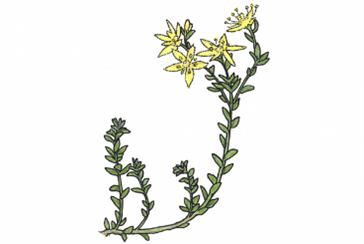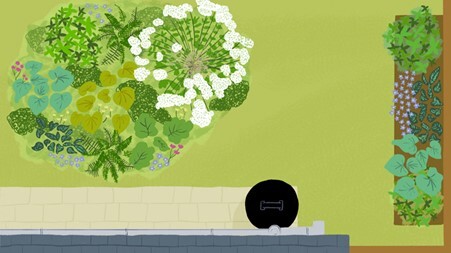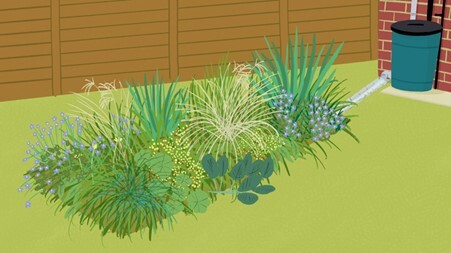Go with the (water) flow
Water – we couldn’t live without it. There are lots of ways to adapt your garden to cope with periods of higher rainfall or droughts.
Adapting your garden to hold on to more water will slow down the movement of water through your space, helping mitigate flood risk and provide for plants and other wildlife.
Create a bog or rain garden
Luckily there are many gorgeous, colourful native plants that happily live in waterlogged, boggy soils and provide for wildlife!
Bog gardens are slow-draining, waterlogged areas of soil planted with moisture-loving plants such as:
| Plant | Image |
| yellow iris/flag (Iris pseudocorus) |  |
| marsh marigold (Caltha palustris) | |
| purple loosestrife (Lythrum salicaria) |  |
| meadowsweet (Filipendula ulmaria) |  |
| hemp agrimony (Eupatorium cannabinum) | |
| dogwood (Cornus sang | |
| primrose (Primula vulgaris) | |
| wall pepper (sedum acre) |  |
.These plants soak up surplus water. If there’s an area of your garden that receives water runoff from buildings or hard surfaces, try diverting the water into an area planted with native species tolerant to waterlogging.
As our climate changes, the UK can expect long dry summers and short periods of heavy rain leading to flooding. A rain or bog garden is designed to deal with both these extremes and to benefit both wildlife and people.
The difference between rain and bog gardens is that even though both are shallow hollows that collect rainwater, rain gardens allow water to drain away into the soil, so they will be dry when it's dry and wet when it’s wet. Bog gardens do not allow this to happen and remain boggy throughout.
What makes a good rain and bog garden?
- It soaks up and stores surplus water, reducing the amount that runs off into drains, so helps to prevent flooding
- It helps reduce pollution - rain gardens are effective in removing up to 90% of nutrients and chemicals and up to 80% of sediments from rainwater runoff
- It uses clever water storage solutions making it less reliant on mains water and better able to survive periods of drought
- It uses plants that can cope with a variety of moisture conditions from droughts to floods
- It attracts and supports nature from bugs to butterflies, birds to bees
- It is visual and sensory, making it a great place for people too
Our gardens are very important for wildlife. There’s actually a greater acreage of gardens than nature reserves in England.
Creating a rain garden
Plan your rain garden
Visualise or sketch out your property looking down
To plan your rain garden, picture your property from above looking down. It is most likely a mosaic, possibly containing roofs, patios, driveways and paths – all often hard surfaces – and lawns, flower beds, ponds and so on – all soft surfaces that will hold rainwater to some extent. Drainage has traditionally been designed so that the rain running off hard surfaces goes straight to the drains. When it really pours down, this can cause sewage to overflow with devastating effects. But even without sudden deluges, the extra water in the surface system increases flooding pressure on the surrounding countryside.
Stop the run-off
First, you need to collect rainwater from impervious surfaces like rooftops, driveways and patios.
Green roofs are a great way to do this as they absorb water and release it slowly down to the garden. They also attract insects, birds, bees and butterflies or, you can use a water butt to collect water. They can be easily attached to the downpipe of any gutter.
Soak it up
The rainwater is then allowed to run into a rain garden, which is designed to temporarily hold and soak up the rainwater so reducing the risk of flooding.
Positioning planters under downpipes is a great way to intercept and soak up water from your roof.
Rills and channels can help you divert the water to where you want it. They can also make fun features for children to play with and they look and sound fantastic.
Using porous paving like paving stones with gravel or planting in the gaps is a great way of reducing runoff and allowing water to soak down to the soil beneath.
Good rain garden plants
A rain garden is dry most of the time. It typically holds water only during and following rain, and they drain within 12 to 48 hours, so you need to choose plants that can survive a range of moisture conditions.
Create a bog garden
A bog garden can be created by adapting an existing soggy area, or from scratch, either at the edge of a pond, or as a standalone feature. As it is permanently damp, it creates an area where moisture-loving plants thrive. These plants are different to those suited to the standing water of a pond, so will attract a host of different wildlife.
A bog garden are safer than ponds for young children. Like a pond, it should attract frogs, toads and even grass snakes. Dragonflies and damselflies will perch on the taller grasses, and bees and butterflies will flit around the flowers.
Planning your bog garden
- Decide on size. Lay out a length of rope or hose to help you to work out the size of your bog garden. Beware of making it very large, though, as it will be harder to maintain and stepping stones may be required.
- Research your plants. Unlike pond plants, bog plants thrive in soil with high nutrient levels and that contain lots of organic matter. There is a huge range of exciting bog plants, from creeping jenny to tiny water forget-me-nots. A little research will reveal their partialities, for instance, whether they are sun- or shade-loving, the degree of damp and acidity preferred, and the amount of space they require.
Establishing your bog garden
- Pick a spot. Making an artificial bog is very like making a pond. Pick a spot on level ground, away from overhanging trees.
- Dig a hole. Dig a hole about 30 cm (12 in) deep.
- Lay a butyl liner in the hole. Make a few drainage slits in the liner and return the excavated soil, mixed with some organic material, to the hole.
- Water the soil thoroughly. Try to use rainwater, especially if the soil is acidic. If tap water is the only means of filling, let it stand for a few days to allow any additives to break down.
- Leave the soil to settle for about a week before planting up.
Maintaining your bog garden
- Plant a combination of short and tall plants for cover and perches.
- Be careful what you plant as some species can be vigorous, aggressive or very large, such as pendulous sedge and gunnera.
- Think about planting so that there is a range of flowers throughout the year, from marsh-marigold in spring, to hemp-agrimony in autumn.
- Water your bog in drought, but respect hosepipe bans. Try to use rainwater if you can.
- Include stepping stones if you bog garden is very big. This will help you to get to the plants as you maintain them without compacting the soil.
Top tips
- If you’re digging your bog garden into turf, place the sods grass-side down around its edge for an instant, nutrient-rich planting medium.
- If a bog garden’s not possible, a miniature version can be created in a container, and planted up. This will probably dry out quicker than a traditional bog garden, so will need topping up with water frequently.
- ‘Palustris’ and ‘ulignosus’ mean ‘bog’ or ‘marsh’ in Latin, so look out for these words in the names of plants, for example, Caltha palustris. It shows that they are appropriate for this environment.
Suggested species:
- Creeping Jenny - Lysimachia nummularia
- Hemp-agrimony - Eupatorium cannabinum
- Marsh-marigold - Caltha palustris
- Meadowsweet - Filipendula ulmaria
- Plantain lily - Hosta spp.
- Snake's-head-fritillary - Fritillaria meleagris
- Water Avens - Geum rivale

